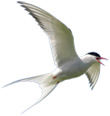
Water chestnut chokes an inlet in the South Lake.
 First introduced to the Lake in the 1940s, water chestnut (Trapa natans L.), is a nonnative plant that forms dense surface mats, crowding out other plant species, disrupting habitat, and severely limiting recreational enjoyment and commercial use of the Lake in some areas. Water chestnut grows each year from distinctive spiny seeds which are the key to controlling the spread of the plant.
First introduced to the Lake in the 1940s, water chestnut (Trapa natans L.), is a nonnative plant that forms dense surface mats, crowding out other plant species, disrupting habitat, and severely limiting recreational enjoyment and commercial use of the Lake in some areas. Water chestnut grows each year from distinctive spiny seeds which are the key to controlling the spread of the plant.
If the plants are removed from the Lake before the seeds are dropped, water chestnuts can be eliminated. Water chestnuts are removed from Lake Champlain by both mechanical harvesters and by hand-pulling.
Since the early 1980s, the Vermont Department of Environmental Conservation, with support from the U.S. Army Corps of Engineers, has run a harvesting program to control the spread of water chestnut in Lake Champlain and prevent its introduction to other areas. Funding is also provided through the Lake Champlain Basin Program. As shown on the Lake Champlain Water Chestnut Annual Funding chart, annual funding is critical to slow the northward spread of water chestnuts. Beginning in 2000, the New York State DEC and Canal Corporation also provided funding for mechanical harvesting in Lake Champlain’s South Bay, which is near Whitehall, NY (not included on chart).
New infestations in 2003 were found on Porters Lake (Ferrisburgh, VT), North Springfield Reservoir (VT), a private pond in Bennington, VT, and at Stoney Point on Lake Champlain (Benson, VT).
Volunteer Program
 The Nature Conservancy (TNC) organizes volunteers to hand-pull water chestnuts that have established themselves in new areas of the lake, and where large mechanical harvesting equipment cannot be used. From 1998 to 2003, TNC pulled 207 tons of water chestnut by hand with the help of volunteers. Volunteers are needed each summer–call TNC at (802) 265-8645 to get involved. Volunteers to help survey in the Adirondacks are also needed by the Adirondack Park Invasive Plant Program.
The Nature Conservancy (TNC) organizes volunteers to hand-pull water chestnuts that have established themselves in new areas of the lake, and where large mechanical harvesting equipment cannot be used. From 1998 to 2003, TNC pulled 207 tons of water chestnut by hand with the help of volunteers. Volunteers are needed each summer–call TNC at (802) 265-8645 to get involved. Volunteers to help survey in the Adirondacks are also needed by the Adirondack Park Invasive Plant Program.
More on Water Chestnut
LCBP Links

LCBP Home
Water chestnut is one of 50 known aquatic non-native and invasive species in Lake Champlain.
Learn More →

State of the Lake
The LCBP and partners take a variety of actions to prevent the arrival and spread of aquatic invasive species.
Learn more →

Opportunities for Action
Managing aquatic invasive species is a priority in the Lake Champlain management plan Opportunities for Action.
Find out more →


 Lake Champlain Basin Program
Lake Champlain Basin Program